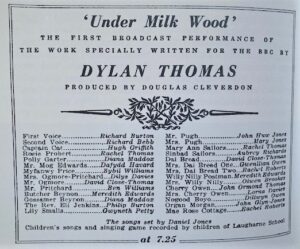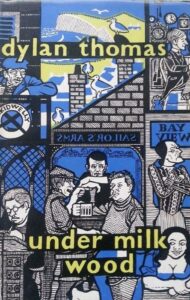Those of you who know me or read my posts on Jan Baynham Writer Facebook page will realise I’m a big fan of Dylan Thomas and his writing, from his wonderful poetry to his short stories and especially his famous play for voices, Under Milk Wood. My first encounter with the play was, in fact, not on the radio but a stage performance at the tiny but grandly named theatre, the Albert Hall, in my hometown of Llandrindod Wells. As a teenager, I can remember being mesmerised by the poetic language, his use of imagery, and the wide range of eclectic and eccentric people he’d created.
 The characters live in a small fictional Welsh village by the sea, named Llareggub (read it backwards!) or Llaregyb (contrary to Thomas’s wishes) in some earlier versions of the play. A long time in its making, the play tells of the ‘dreams, fantasies and realities of the inhabitants’ of Llareggub ‘as they unfold across the cycle of one spring day’. The villagers are presented in a humorous, ribald way, created and exaggerated maybe from the poet’s observations of the oddities and the pieces of gossip of a small-town community that he lapped up every morning in Brown’s Hotel in Laugharne, Carmarthenshire.
The characters live in a small fictional Welsh village by the sea, named Llareggub (read it backwards!) or Llaregyb (contrary to Thomas’s wishes) in some earlier versions of the play. A long time in its making, the play tells of the ‘dreams, fantasies and realities of the inhabitants’ of Llareggub ‘as they unfold across the cycle of one spring day’. The villagers are presented in a humorous, ribald way, created and exaggerated maybe from the poet’s observations of the oddities and the pieces of gossip of a small-town community that he lapped up every morning in Brown’s Hotel in Laugharne, Carmarthenshire.
The play opens at night and a narrator invites the audience to listen in on the dreams of the townspeople of Llareggub while they sleep, “from where you are”.
“To begin at the beginning:
It is spring, moonless night in the small town, starless and bible-black, the cobblestreets silent and the hunched’-and-rabbits’ wood limping invisible down the sloeblack, slow, black, crowblack, fishingboat-bobbing sea…”
We are taken straight there, invited to listen to the villagers’ innermost thoughts. They include Captain Cat, the blind sea captain, reliving his times at sea and his drowned ship mates and Mrs. Ogmore-Pritchard, relentlessly nagging her two dead husbands. Almost all the characters in the play are introduced as the audience witnesses a moment of their dreams until “…dawn inches up.”
 Through the characters, more than sixty of them, we are given a glimpse of village life albeit through their eccentricities. The Reverend Eli Jenkins delivers a morning sermon about his love for the village. I love the choice of names – Gossamer Beynon, Willy Nilly, Evans the Death, Dai Bread, Nogood Boyo. Through their actions and what they say, the characters come alive. Taking up her morning tea, Mr. Pugh imagines poisoning his nagging wife and whispers:
Through the characters, more than sixty of them, we are given a glimpse of village life albeit through their eccentricities. The Reverend Eli Jenkins delivers a morning sermon about his love for the village. I love the choice of names – Gossamer Beynon, Willy Nilly, Evans the Death, Dai Bread, Nogood Boyo. Through their actions and what they say, the characters come alive. Taking up her morning tea, Mr. Pugh imagines poisoning his nagging wife and whispers:
“Here’s your arsenic, dear.
And your weedkiller biscuit…
Here’s your…
…nice tea, dear.”
At Mrs. Organ-Morgan’s general shop, women gossip about the townspeople. Children play in the schoolyard; Polly Garter scrubs floors and sings about her illicit lovers of the past. Later, Mrs. Organ-Morgan shares some of that gossip with her husband:
“I saw you talking to a saint this morning. Saint Polly Garter. She was martyred again last night…”
As night begins, Reverend Jenkins recites another poem. Cherry Owen heads to the Sailor’s Arms, where Sinbad still longs for Gossamer Beynon. The town prepares for the evening and the inhabitants of Llareggub return to their dreams again.
Since my first introduction to Under Milk Wood as a teen, I’ve heard it played many times with a variety of casts, seen stage performances and film versions. It never fails to intrigue me, and I find new snippets of language to marvel at each time. It has been called poetry but Dylan Thomas’s own description of it is ‘prose with blood-pressure’! If you are not familiar with the play, I can’t recommend it highly enough.

